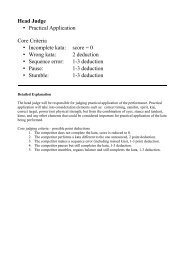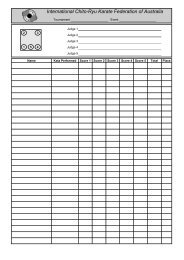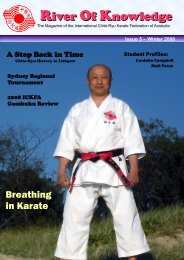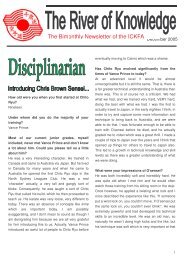kata rules v1.2.pdf
kata rules v1.2.pdf
kata rules v1.2.pdf
Create successful ePaper yourself
Turn your PDF publications into a flip-book with our unique Google optimized e-Paper software.
Kata – Rules of CompetitionKata Competition – The Competition AreaShiroIndividualAka2 13Table Officials1. The inner competition area will be 6m x 6m, with a 2m border on all sides, giving a totalcompetition area of 10m x 10m.2. The judges will be seated, so that the head judge is in position 1, the second judge inposition 2 and the third judge in position 3.3. Three lines will be marked (50cm in length) where competitors will stand before and afterperforming their <strong>kata</strong>.1. All lines will be placed 1m from the rear inner boundary.2. The shiro and aka lines will be placed, with the closest end 1m from the left and rightinner boundary accordingly. This is where competitors will stand before and afterperformances during preliminary rounds when two competitors perform simultaneously.3. The individual line will be placed equidistant from the left and right boundary of thecompetition area. This is were competitors stand before and after performances in thefinal round.Kata Competition – Competitors and Officials Clothing Attire[As per ICKF <strong>rules</strong>]
Kata Competition – The Process of Elimination1. If there are 6 or less competitors in a division, there will only be one round of competition.2. If there are 7-18 competitors in a division, there will be two rounds of competition with the6 highest scoring competitors from the first round progressing to the second and final round.3. If there are 19 or more competitors in a division, there will be three rounds of competitionwith the 18 highest scoring competitors in the first round progressing to the second round,and then the 6 highest scoring competitors from the second round progressing to the third ndfinal round.4. For individual <strong>kata</strong>, if there is more than one round of competition in a division, twocompetitors will perform at once during the preliminary rounds, and in the final round only,all competitors will perform individually.5. For team <strong>kata</strong>, only one team will perform at a time, in all rounds.Kata Competition – Organisation of the Competition & The Role of the Head Judge1. Preliminary rounds - Starting the performance:1. Two competitors are called into the competition area at the same time.2. When in place, the head judge indicates with the left hand towards SHIRO, thecompetitor on the left (from the head judge's perspective) announces the name of the<strong>kata</strong> that they are going to perform, and the head judge repeats the <strong>kata</strong> name.3. Following this the head judge then indicates with the right hand towards AKA, thecompetitor on the right (from the head judge's perspective) announces the name of the<strong>kata</strong> that they are going to perform, and the head judge repeats the <strong>kata</strong> name back to thecompetitor.4. The head judge then announces “hajime” and both competitors commence their <strong>kata</strong>performance.2. Preliminary rounds - After both competitors have performed <strong>kata</strong>:1. The head judge indicates towards shiro and announces “shiro hantei”, then blows thewhistle once and all judges raise their score cards facing towards the table officials andthe score are called by a table official in the order of head judge, second judge, thirdjudge and recorded on the score sheet.2. The head judge blows the whistle again and the score cards are turned towards thespectators, then after a short pause are lowered.3. The head judge then indicates towards aka and announces “aka hantei”, then blows thewhistle once and all judges raise their score cards facing towards the table officials andthe score are called by a table official in the order of head judge, second judge, thirdjudge and recorded on the score sheet.4. The head judge blows the whistle again and the score cards are turned towards thespectators, then after a short pause are lowered and both competitors exit the ring.3. Final round:1. One competitor is called into the competition area at a time.2. After entering the ring, the competitor announces the <strong>kata</strong>, the head judge repeats the<strong>kata</strong> name, commands “hajime” and the competitor begins.3. The head judge announces “hantei”, then blows the whistle once and all judges raisetheir score cards facing towards the table officials and the score are called by a tableofficial in the order of head judge, second judge, third judge and recorded on the scoresheet.4. The head judge blows the whistle again and the score cards are turned towards thespectators, then after a short pause are lowered and the competitor exits the ring.
4. Table official notes.1. All 3 scores are recorded and added together. Competitors are then ranked according tothe highest total score.2. When the tied scores determine who progresses to the next round or who places in thedivision a count back will occur.1. The head judges score will be compared for each competitor. The competitor withthe highest score wins.2. If scores are identical from the head judge, the second judges score will be comparedfor each competitor. In this case, the competitor with the highest score wins.3. If a tie remains the tied competitors will perform another <strong>kata</strong> to break the tie.3. Table officials must record the <strong>kata</strong> being performed. Once a <strong>kata</strong> has been performed itmay note be used again in future rounds or to decide a tie. If a competitor repeats a <strong>kata</strong>,the head referee will be notified before the scores are presented and the competitor willbe disqualified (scored 0).Kata Competition – The Judging Panel and Scoring Criteria1. The judging panel will be made up of 3 judges.2. Each judge will be responsible for judging a different component of the performance inaddition to core criteria that all judges will use giving a score from 0-10.3. Each judge is responsible for judging their specific component of the performance inaddition to the core judging criteria.4. Core judging criteria – possible point deductions1. The competitor does not complete the <strong>kata</strong>, score is reduced to 0.2. The competitor performs a <strong>kata</strong> different to the one announced, 2 point deduction.3. The competitor makes a sequence error (including missed kiai), 1-3 point deduction.4. The competitor pauses but still completes the <strong>kata</strong>, 1-3 deduction.5. The competitor stumbles, regains balance and still completes the <strong>kata</strong>, 1-3 deduction.5. The head judge will be responsible for judging practical application of the performance.Practical application will take into consideration elements such as: correct timing, zanshin,spirit, kiai, correct target, power (not physical strength, but from the combination of eyes,stance and tanden), kime, and any other elements that could be considered important forpractical application of the <strong>kata</strong> being performed.6. The second judge will be responsible for judging eye focus, stance, breathing and use oftanden. This judge will take into consideration, the competitors ability to perform correctsuri ashi, shime, enzan no metsuke, use of peripheral vision, timing of breathing, smoothtransitions from one position to the next and any other areas that could be consideredimportant to eye focus, stance, breathing or use of tanden.7. The third judge will be responsible for judging correct form of techniques, taking intoconsideration: pull back (hikite, hikiashi), correct fist/hand/foot position, correctpreparation of techniques, correct posture, telegraph of techniques and any other areas thatcould be considered important in relation to the competitors ability to demonstrate correctform of the techniques that make up the <strong>kata</strong>.Commentary – How Judges Should Score…..














